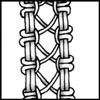 Greetings folks, thanks as always for the pleasure of your company 🙂
Greetings folks, thanks as always for the pleasure of your company 🙂
Today Belgian CZT Ria Matheussen is back with us after a bit of a break for a few months to share her fascinating Quippu tangle with us. It’s delightful seeing her back again and of course exploring one of her many, fascinating tangle deconstructions.
Ria introduces Quippu, explains the meaning of its name and shares some background images to go with her tangle:
Quipu is an ancient knotting technique, used by the Inca’s of Peru for administrative data and censuses. Each knot in the treads (ropes) had a specific meaning. I added a “p” in the middle (from Peru).
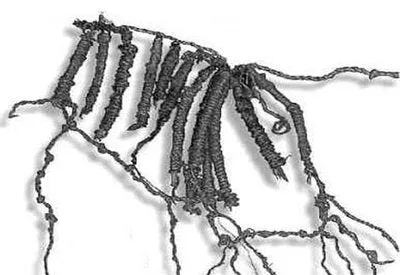
The Quipu of Caral, 3000 BC, Peru
Other ancient civilizations such as Egypt, the Middle East and China also started to use a similar technique to make fishing nets, belts, straps… Little by little this early form of “Macramé” became known all over the world.
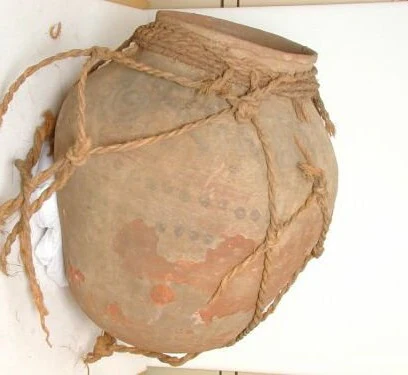
Netted pots for beauty and practicality, from 3500 BC, Egypt
In the 13th century, Macramé became famous because several people began to use this technique to create nice decoration objects, jewelry and cloths.
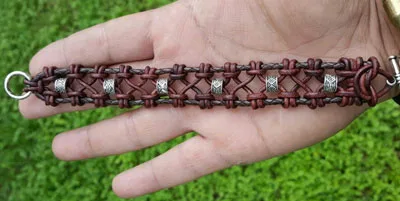
In the 20th century, Macramé became less popular but the technique got a comeback in the seventies and also at this moment it is still used as a form of art. This picture inspired me to deconstruct this pattern.
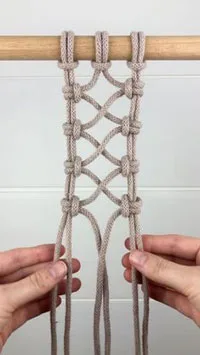
I discovered more tangles, based on this old technique, a real beauty is “Mak-rah-mee” from CZT Michele Beauchamp.
What is Quipu? Would you believe ancient computers?
From the website PeruForLess.com:
A quipu, also spelled khipu, qipu or kipu, is an intricate system of knotted strings of various colors that store and convey information. Quipu literally translates to “knot” in Quechua. Many ancient Andean cultures used this knot system, including the Inca. Sometimes referred to as “talking knots,” they served as a writing system. This was crucial since there was no formal written language. Though just strings and knots, the arrangement was extremely precise and sophisticated, communicating everything from accounting to genealogy. Made from cotton or camelid fibers, quipus were portable making it easy to transfer information over distances and store over time.
This brief 3-minute video is also from PeruForLess:
Isn’t it amazing what we learn from tangling. And while the quipu system generated some beautiful (informative) knotwork, I’m thinking “thank goodness for time-saving pencil and paper!”
As complex as Quippu the tangle looks, it’s really very simple “one stroke at a time”. And shading makes a big difference.
Ria illustrates the step-by-step instructions for drawing Quippu below with examples of variations and two beautiful examples she describes here: “As you can see, I added a few variations: with an extra “knot” and a second variation with the knots closer to each other. I think more variations are possible … Quippu can be used in a straight or flexible way, as a border, as a frame, but I also like it very much, drawn in the round. When my drawing was finished I saw a nice string popping up which I filled with Flux, Striping and Ahh. In the first example I used Quippu together with Myko.”
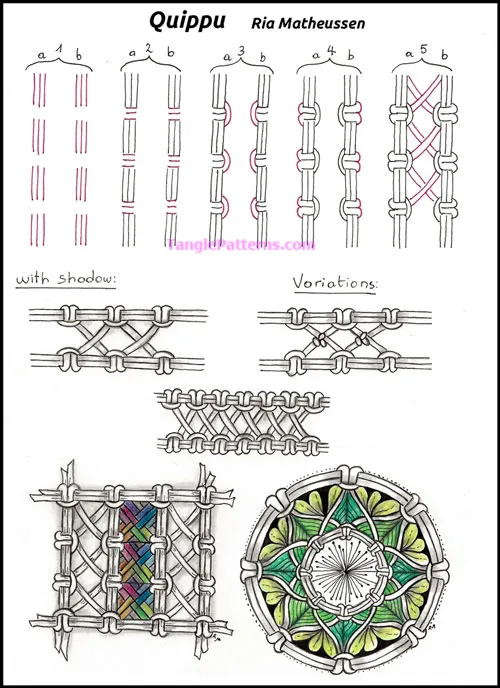
Image copyright the artist and used with permission, ALL RIGHTS RESERVED. These images are for your personal offline reference only. Please feel free to refer to the images to recreate this tangle in your personal Zentangles and ZIAs. However the artist and TanglePatterns.com reserve all rights to the images and they must not be publicly pinned, altered, reproduced or republished. (Small side note: if you look at the legalese in Pinterest, you are legally responsible for obtaining permission to post every photo that gets ‘Pinned’. Giving credit or sharing the source link doesn’t count.) Thank you for respecting these rights. “We must all face the choice between what is right and what is easy.” ~ Albus Dumbledore
As you enjoy any of the tangles on the site, please leave a comment of thanks and encouragement to show the artists you appreciate them for sharing their creativity to inspire yours. Your thanks helps motivate them to continue to share! And please share a link to your favorite tangles on social media. Thanks!
Check out the tag riam for more of Ria’s tangles on TanglePatterns.com.
Related Links
- Looking for tangles by Artist or Type? For details visit the ABOUT > HOW TO FIND TANGLES BY ARTIST OR TYPE page on the top menu bar of any page on the site.
- What is a Zentangle? — if you are new to the Zentangle Method, start here for the fundamentals.
- Zentangle terminology — a glossary of terms used in this art form.
- How to use the site — an excellent free video tutorial showing how to use the site as well as pointing out lots of useful features you might have missed.
- Linda's List of Zentangle-Original Patterns — here is the complete list of original tangles (aka "official tangles") created and introduced by founders Rick Roberts and Maria Thomas, including those not published online. If you are new to the Zentangle Method I highly recommend learning a few of the published Zentangle classics first.
- "A Zentangle has no up or down and is not a picture of something, so you have no worries about whether you can draw a hand, or a duck. You always succeed in creating a Zentangle." Patterns that are drawings of a recognizable naturalistic or actual object, figure, or scene, are not tangles. A pattern is not always a tangle — here's what makes a tangle. TIP: tangles never start with pencil planning.
- Un motif n’est pas toujours un tangle — Qu’est-ce qu’un tangle ?
- Un diseño no es siempre un tangle — ¿Qué es un tangle?
- How to submit your pattern deconstruction to TanglePatterns
- For lots of great FREE tutorials on TanglePatterns, click on the TUTORIALS link in the pink alphabetic menu bar below the tangle images at the top of any page.
- Strings! Have we got STRINGS! Click on the STRINGS link in the pink alphabetic menu bar below the tangle images at the top of any page for 250 different (free) Zentangle-starters. More than enough for any lifetime!
- Never miss a tangle! FREE eMAIL NEWSLETTER - visit the Here's how to SUBSCRIBE button (top of left sidebar on any page) and sign up to get notices delivered free to your inbox.
- If you have questions about the TanglePatterns.com TANGLE GUIDE, visit the BOOK REVIEWS tab on the top menu bar of any page on the site for COMPLETE details!
|
.oOo. |
|
Enhance your Zentangle experience while supporting TanglePatterns: |
|
CURRENT EDITION! TanglePatterns.com TANGLE GUIDE, 2025 Edition |
|
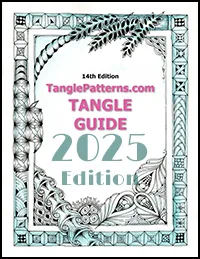 |
The 14th Edition of the TanglePatterns.com TANGLE GUIDE is an instant-download 117-page interactive digital eBook/PDF containing over 2,000 tangles on the site from May 2010 through December 31, 2024. It's a great resource and a must-have digital tool for using the site. Visit the STORE > E-BOOKS page and help keep TanglePatterns.com going by getting your copy now! |
|
"Linda, Thank you! I was relying on too few and getting stuck after 3 years of daily working with Zentangle. This has inspired me to ‘begin again’ with renewed excitement." ~ Barbara R. |
|
| See the BOOK REVIEWS page for more details on its features and view a sample page. Note: this is a digital product you download immediately when you place your order, nothing will be physically mailed to you. | |
| If you're new to Zentangle® and tangling, my TanglePatterns.com BEGINNER'S GUIDE TO ZENTANGLE is just what you need to get started. Also available en Français and en Español. | |
|
|
|
 |
This is the only Zentangle book you'll ever need: the fabulous Zentangle PRIMER Vol 1. It's your CZT-in-a-book by the founders of Zentangle®. Visit the STORE tab on the top menu bar or click on the image. For more about the content and to read the rave reviews, visit the BOOK REVIEWS tab. |
| Now available in KINDLE format for $9.99. Spanish Edition here. Japanese Edition here. | |
| "Absolutely the best Zentangle Book yet! As an accomplished artist I used to think I did not need instruction on this art form. How wrong I was! My tangling improved by leaps and bounds after reading this book. If you think you have Zentangle down then you need this book more than ever!" ~ Kris H | |
|
|
|
|
.oOo. |
|






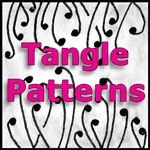
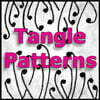
Oh, Ria, what a beautiful tangle!!! And your stepout is perfect. I can’t wait to draw it! Hugs, Jan
Thanks so much for your kind comment Jan, makes me glad to hear from you again and wish you succes while drawing! Hugs too from Belgium!
Ria, This one looks like fun. it also looks like it took a fair amount of time to produce this tangle for us. Thank you
Giving a new tangle a right name, that is always difficult for me. By coincidence I have found the connection of Macramé, as we know it now and the early forms, f.ex. Quipu from Peru. So it was interesting to find out more information and before I know, there was a whole story. Thank you for your kind comment and hope Quippu will give you fun while exploring.
Love this tangle!!
How pleasant to know. Thank you very much Cathy for your comment and I wish you a pleasant time while drawing Quippu!!!
What an awesome post, Ria! Your new tangle is so beautiful, and the story behind its creation makes it even more special. Thank you very much! I need to give it a try.
It was by coincidence that I found inspiration to decontruct a pattern in the lovely “world” of Macramé.It was interesting to learn how it all started…Thank you very much Beatrice for letting me know by this way you like it. Several variations are possible… Wish you a pleasant stay by the Ocean and lots of tanglepleasure!
This is wonderful! Thank you so much for sharing this tangle and the explanation behind it. I see very many different ways I will be using it.
Indeed, Donna, there are several ways to use this tangle. When you draw just one “square”Quippu can be used as a frame that you can fill with other tangles… I wish you fun while exploring and thank you very much for your kind comment.
Ria, this is a beautiful pattern! Back in the ‘70’s, Macramé was very popular. I had a friend that made gorgeous Macamaë’s for Christmas presents. She had plants hanging in them and some of them had glass with plants in them as well. This pattern takes me back a few years and many good memories. Thank you for sharing!
I also like Macramé work and even at this moment, workshops are popping up to learn this technique… Thank you very much Sharon for your sweet story and I hope you will have a good time while explore Quippu!!!
At the moment, I have become again more time and, as I did earlier,I like searching for new tangles. It’s makes me glad to see them published on this great site, a great source of inspiration for everyone. Thank you very much Linda and fun for everyone!
Ria, this tangle is BEAUTIFUL! You made the step out so logical and easy to follow! I love it, and can’t wait to try it! Thanks!
That’s a nice compliment, thank you very much. I wish you fun while exploring.
Tried the round one! It was a lot of fun.
Thanks for letting me know that you had fun while trying Quippu!